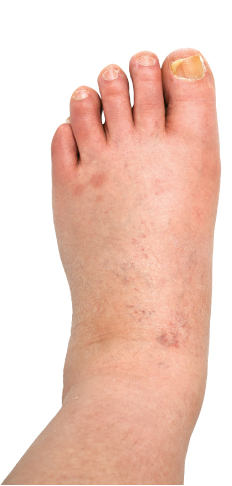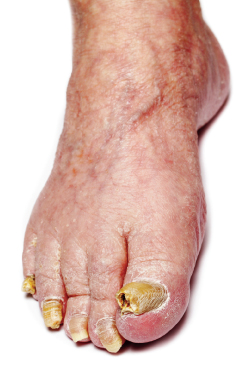Our feet are the literal foundation to our bodies. They are the reason we can stand upright and achieve various tasks such as walking, running, skipping, dancing and jumping. Throughout time, they have inspired positive feelings of fascination, adoration, obsession and intrigue, as well as negative sensibilities of repugnance and disgust. Oftentimes, they spend their time hidden away.
Sometimes, they are the source of laughter and, at other times, they can be a source of pain. Ultimately, however, we depend on our feet daily and they are often taken for granted unless they are causing us pain. They are a flexible part of our anatomy constructed of 26 bones; 33 joints; more than 100 muscles, tendons and ligaments; and a network of blood vessels, nerves, skin and soft tissue. Therefore, it should not be surprising that their overall health can affect the entire body. Many specialists, from podiatrists to reflexologists, believe that taking a closer look at the condition of one’s feet can expose health issues that may have otherwise gone unnoticed.
As skin care professionals, it is beyond the scope of practice to diagnose health conditions clients may be dealing with. Nevertheless, taking the time to check and examine clients’ feet will allow the professional to ascertain if there might be other health problems present that could explain or exacerbate the client’s skin care concerns. Below is a list of several warning signs and conditions that feet can possess.
 Swollen Feet
Swollen Feet
It can be painful, inconvenient and troublesome. Peripheral edema is the medical description for when the tissues in the lower limbs of the body swell due to the accumulation of fluids. This condition does not discriminate; anyone at any age can be affected, although it is more common in adults. Occasionally, healthy individuals can experience this ailment and it generally resolves itself after they have rested and/or elevated their feet. It can occur in one or both feet and it is generally painless. Swelling can be brought on by various causes, such as being overweight, a person’s age, consuming too much salt and/or alcohol, menstruation, being pregnant, sitting or standing for too long, certain medications, and so on. Persistent swelling could be an indication of other conditions, such as high blood pressure, a problem with the thyroid, venous insufficiency, an allergic reaction, sodium retention, a lymphatic obstruction, and so on. Most importantly, individuals should be aware that if the swelling is painful it could be a sign of another, more severe, problem and they should contact their general practitioner immediately.
Brittle Toenails
The human body, like most well-oiled machines, functions best when all of the parts are running smoothly and has the necessary resources. Such resources, or fuel, for the human body include the minerals and vitamins that we ingest. Unfortunately, vitamin and mineral deficiency can occur when the body does not receive the necessary resources. One outward sign of such a deficiency can manifest in the outward appearance of brittle toenails. This condition can also be caused by the toenail drying out or as the result of a fungal infection. There is also evidence that indicates an underactive or overactive thyroid can sometimes cause brittle toenails.1 Furthermore, this condition can simply be another apparent indication that the individual is aging.
Cracked Heels
Also known by the medical description of heel fissures, cracked heels are when an individual experiences split skin around the heel. The cause of this condition is related to the skin located on the bottom, outer edge of the heel. Though it is commonly the result of the skin in the area being too hard and dry, it can also be due to the skin being too soft and wet. When the skin located on this area of the foot cannot handle typical everyday pressures, such as walking or standing, it will split due to its inflexibility. More times than not, this problem is a concern of appearance, however on some occasions it can result in extreme pain brought on by deep fissures and sometimes bleeding. As with any condition, if heel fissures go untreated or become infected they can lead to a more dangerous situation – especially for individuals with weak immune systems
or diabetes.
Pitted Toenails
Rippled or pitted toenails are characterized by small depressions or tiny holes in the nails, and it is commonly associated with individuals who have psoriasis, roughly affecting 10 to 50 percent of clients with that
disorder.2, 3 This condition can also be the result of atopic dermatitis (eczema), irritant dermatitis (erythema, mild edema and scaling), allergic contact dermatitis, reactive arthritis, and alopecia areata.
Hairless Feet
For many individuals, hairy feet and toes are not attractive. In fact, adding a weekly, if not daily ritual of shaving to rid the hair from this part of the body has become routine for some men and women. However, medically speaking, the presence of hair on the feet is actually considered a good thing, whereas the non-existent presence of hair on a person’s feet could be a sign of poor circulation. When the hair follicles on the feet do not have enough circulation to remain intact, it may cause the blood vessels present under the skin to die off, thereby killing the hair follicles. Individuals experiencing some form of a vascular disease and/or a weak heart can typically suffer from this condition.
 Slightly Sunken
Slightly Sunken
(Spoon-shaped) Toenails
Medically known as koilonychia, this condition is illustrated by a diagonal and lengthwise indentation of the nail that causes it to take on a spoon-shaped appearance. Nails that suffer from this disfigurement are typically soft, very thin and rather brittle. This abnormality does not only affect the shape of the nail; it can also influence the color, texture and thickness of toenails and fingernails. Koilonychia has been associated with iron deficiency, with or without resultant anemia. Interestingly, it occasionally occurs in clients with hemochromatosis.4
Blisters and Bunions
When it comes to blisters and bunions, the usual culprit for both are shoes – whether they are old, new, ill-fitting or badly made. When an individual is on their feet for long periods of time, walking, standing, running, jogging, dancing and so on, it can cause stress to their feet. However, when all of these actions take place while the individual is wearing shoes that are too tight, stiff, high or old, it can cause pain in their feet.
Usually due to a combination of friction, heat and motion, blisters can be painful and troublesome. With over 250,000 sweat glands in each foot, it should not be a surprise that when the feet sweat the added lubrication allows shoes to rub against different parts of the feet, which can possibly result in a blister. However, blisters can also be brought on from simply wearing shoes that do not fit properly.
Like with blisters, bunions are also typically brought on by ill-fitting shoes and the stress and pressure the feet experience as a result. Unlike blisters, however, the discomfort is not localized on the skin but on the bone/joint. What exacerbates the condition further is the shape and style of the shoes the individual wears. If the shoe is too-narrow, the toes are pushed together, like with high heels it can cause the foot to try to compensate for the bad positioning and lack of space – in most cases causing the big toe to lean toward the other toes. As a result, fluid is developed at the point of aggravation or abrasion. The bone then begins to grow in an effort to push away from the offending area resulting in a bony bump that develops at the base of the big toe, otherwise known as a bunion. Due to their presence on the joint of the big toe, bunions can be exceedingly painful since this part of the foot bares the weight of the entire body and normally bends with walking. Throw in the added pressure and friction brought on by shoes that do not fit correctly and not only does the pain increase but the individual can also develop more
serious complications.5
Thick, Yellow Toenails
This condition can affect one or several toenails at a time. It can be disturbing to look at which, oftentimes, leads to the offending appendage being hidden away in socks and/or shoes. Though unsightly, toenails that are thick and yellow could simply be the result of poor hygiene. It is also important to realize that the yellow tint on a toenail could be the residual effects of chemicals found in some nail polishes. If the yellow hue is resistant to being removed by a nail file, then chances are that the yellow toenail is a sign of a larger, more serious condition.
There are various conditions and diseases that can result in the development of yellowing toenails. The rarest form of this condition is a rare genetic disorder known as yellow nail syndrome. Individuals with this disorder have thickened nails, experience slow nail growth, nails that depict a yellow to yellow-greenish discoloration, and may lack cuticles.
Many individuals that experience unattractive, thick, yellow toenails suffer from a fungal infection of the toenail. Fungal infections are signified by thicker toenails that have striations of discoloration across the nail bed, in addition to being more brittle. Although fungal infections of the toenails are fairly common, they can go undetected for years because the early warning signs are very subtle. If left untreated, the infection can spread and can eventually lead to extremely thick toenails, numbness, tingling, pain, and/or a separation of the toenail from the bed. In severe cases, it can become excessively painful to the point where an individual will begin to have trouble walking.
Although many of the conditions included within this article are fundamentally beyond the scope of practice for skin care professionals, knowing and understanding them can be highly beneficial in the aesthetics industry. When a skin care professional is knowledgeable enough to recognize any condition present and utilize that knowledge to maximize their ability to treat the client’s skin care concern, it not only benefits the client but their business as well.
Resources
1 www.livestrong.com. “What are the Causes of Brittle Toenails?” 29 Nov 2010. Web. 14 Nov. 2014.
<http://www.livestrong.com/article/321052-what-are-the-causes-of-brittle-toe-nails>.
2 www.mayoclinic.com. Adult health. “Slide show: 7 fingernail problems not to ignore.” 8 Dec. 2011. <http://www.mayoclinic.com/health/nails/WO00055>.
3 Mayeaux, EJ Jr. Nail disorders. Prim Care. 2000;27:333–51
4 Barnett JM, Scher RK, Taylor SC. Nail cosmetics. Dermatol Clin. 1991;9:9–17
5 www.webmd.com. “Understanding Bunions -- the Basics.” 24 Mar 2013. Web. 14 Nov. 2014.
<http://www.webmd.com/skin-problems-and-treatments/understanding-bunions-basics>.
Want to read more?
Subscribe to one of our monthly plans to continue reading this article.